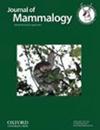重访多型物种:栉水母(Chiroptera: Phyllostomidae)的系统发育和形态变异、分类地位和地理分布
IF 1.6
3区 生物学
Q2 ZOOLOGY
引用次数: 0
摘要
通过一项综合研究,对新热带蝙蝠属(Trachops)的分类地位进行了重新评估,该研究结合了其广泛地理范围内的形态学、形态计量学和分子数据。我们的研究包括了以前未曾考察过的地理区域,揭示了训尾蝠属的多样性。由于巴西东南部标本的差异,遗传学和形态学结果支持将分布在巴西大西洋森林中的 T. cirrhosus ehrhardti 提升为物种。c.c coffini缺乏可诊断的形态特征,而且在整个分布区与T.此外,我们的研究结果还对之前关于T. cirrhosus体型纬度分化的观点提出了质疑,因为南美洲西部和南美洲东北部的标本与中美洲的标本体型相似。这些结果强调了修订该蝙蝠属分类框架的重要性--有助于更准确地了解其进化关系,并进一步加强保护工作,考虑到巴西大西洋森林中濒临灭绝的新物种所面临的潜在威胁。本文章由计算机程序翻译,如有差异,请以英文原文为准。
A polytypic species revisited: phylogenetic and morphological variation, taxonomic status, and geographical distribution of Trachops (Chiroptera: Phyllostomidae)
The taxonomic status of the Neotropical bat genus Trachops is reevaluated through an integrated study that incorporates morphological, morphometric, and molecular data across its extensive geographic range. Our research, which included previously unexamined geographical regions, revealed substantial insights into the diversity within Trachops. Genetic and morphological results support elevation of T. cirrhosus ehrhardti, distributed within the Atlantic Forest of Brazil, to species status due to differences in southeastern Brazil specimens. Conversely, our analysis found insufficient evidence to maintain the subspecific distinction of T. c. coffini, which lacks diagnosable morphological characters and is not genetically distinct from T. c. cirrhosus across its distribution range. Additionally, our findings challenge a prior notion of latitudinal differentiation in body size in T. cirrhosus, because specimens from western South America and northeastern South America exhibit similar sizes to those from Central America. These results underscore the importance of revising the taxonomic framework for this bat genus—contributing to a more precise understanding of its evolutionary relationships—and further enhancing conservation efforts considering potential threats to the newly recognized species in the imperiled Atlantic Forest of Brazil.
求助全文
通过发布文献求助,成功后即可免费获取论文全文。
去求助
来源期刊

Journal of Mammalogy
生物-动物学
CiteScore
3.30
自引率
5.90%
发文量
106
审稿时长
4-8 weeks
期刊介绍:
Papers are published on mammalian behavior, conservation, ecology, genetics, morphology, physiology, and taxonomy.
 求助内容:
求助内容: 应助结果提醒方式:
应助结果提醒方式:


